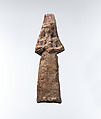Apkallu figure: male with a fish-skin hood
Not on view
This small baked clay figurine takes the form of a male figure with long hair and beard, staring straight ahead with large, wide-open eyes beneath arched eyebrows. A prominent nose and small, closed mouth can also be seen, although the level of detail in the features is minimal. He presses both fists to his chest, right above left. Shiny areas of the surface are modern restorations in wax. His tall rounded headdress indicates that he is wearing a fish-skin cloak, a garment associated with Assyrian priests that likely connects them with the ancient sages of Mesopotamian mythology who lived in the Apsu, a subterranean realm of fresh water. The figurine was made by pressing clay into a mold, a common method of manufacturing plaques and figurines in Mesopotamia since at least the Ur III period (ca. 2100-2000 B.C.). A thousand years later, during the Neo-Assyrian period, practitioners of magic had developed techniques for protecting interior spaces of buildings by means of a ritual that involved depositing an assemblage of figurines beneath the room’s floor. This figure was found buried under the floor in a room in a palace building at the Assyrian royal city of Nimrud, suggesting that it was intended for this function.
Due to rights restrictions, this image cannot be enlarged, viewed at full screen, or downloaded.
This artwork is meant to be viewed from right to left. Scroll left to view more.



